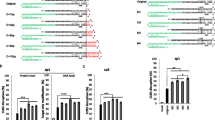Abstract
The CRISPR (clustered regularly interspaced short palindromic repeats)-Cas (CRISPR-associated protein) system has become a popular toolkit for editing genomes of interest in a wide variety of organisms. The Cas9 endonuclease enzyme is targeted to a specific genomic region by a small single guide RNA (sgRNA). The cleavage efficiency of Cas9 varies greatly from one sgRNA to another sgRNA. Mutagenesis rate of a CRISPR-Cas experiment strongly depends on the sgRNA used. Presently accessible web-based tools for sgRNA design predict a wide variety of candidate sgRNAs for a single genomic target site. Despite these in silico predictions, not every sgRNA displays the same cleavage efficiency. To encounter this discrepancy, here, we present an in vitro method to screen multiple sgRNAs to identify the most suitable one that can efficiently introduce a double-stranded break at a particular genomic target site. This screening method allows a researcher to choose the best one among several online predicted sgRNAs prior to deliver genome editing reagents into live plant or animal cells.
Access this chapter
Tax calculation will be finalised at checkout
Purchases are for personal use only
Similar content being viewed by others
References
Horvath P, Barrangou R (2010) CRISPR/Cas, the immune system of bacteria and archaea. Science 327(5962):167–170
**e K, Yang Y (2013) RNA-guided genome editing in plants using a CRISPR–Cas system. Mol Plant 6(6):1975–1983
Mali P, Aach J, Stranges PB, Esvelt KM, Moosburner M, Kosuri S et al (2013) Cas9 transcriptional activators for target specificity screening and paired nickases for cooperative genome engineering. Nat Biotechnol 31(9):833–838
Doudna JA, Charpentier E (2014) The new frontier of genome engineering with CRISPR-Cas9. Science 346(6213)
Gasiunas G, Barrangou R, Horvath P, Siksnys V (2012) Cas9–crRNA ribonucleoprotein complex mediates specific DNA cleavage for adaptive immunity in bacteria. Proc Natl Acad Sci U S A 109(39):E2579–E2586
Deltcheva E, Chylinski K, Sharma CM, Gonzales K, Chao Y, Pirzada ZA, Eckert MR, Vogel J, Charpentier E (2011) CRISPR RNA maturation by trans-encoded small RNA and host factor RNase III. Nature 471:602–607
**ek M, Chylinski K, Fonfara I, Hauer M, Doudna JA, Charpentier E (2012) A programmable dual-RNA–guided DNA endonuclease in adaptive bacterial immunity. Science 337(6096):816–821
Molla KA, Karmakar S, Islam MT (2020a) Wide horizons of CRISPR-Cas-derived technologies for basic biology, agriculture, and medicine. In: Islam, Bhowmik, Molla (eds) CRISPR-Cas methods. Humana, New York, NY, pp 1–23
Molla KA, Yang Y (2020b) Predicting CRISPR/Cas9-induced mutations for precise genome editing. Trends Biotechnol 38(2):136–141
Sternberg SH, Redding S, **ek M, Greene EC, Doudna JA (2014) DNA interrogation by the CRISPR RNA-guided endonuclease Cas9. Nature 507(7490):62–67
Butler ET, Chamberlin MJ (1982) Bacteriophage SP6-specific RNA polymerase. I. Isolation and characterization of the enzyme. J Biol Chem 257(10):5772–5778
Davanloo P, Rosenberg AH, Dunn JJ, Studier FW (1984) Cloning and expression of the gene for bacteriophage T7 RNA polymerase. Proc Natl Acad Sci U S A 81(7):2035–2039
Jorgensen ED, Joho K, Risman S, Moorefield MB, McAllister WT (1989) Promoter recognition by bacteriophage T3 and T7 RNA polymerases. DNA-protein interaction in transcription: 79–88
Melton DA, Krieg PA, Rebagliati MR, Maniatis T, Zinn K, Green MR (1984) Efficient in vitro synthesis of biologically active RNA and RNA hybridization probes from plasmids containing a bacteriophage SP6 promoter. Nucleic Acids Res 12(18):7035–7056
Krieg PA, Melton DA (1987) In vitro RNA synthesis with SP6 RNA polymerase. Methods Enzymol 155:397–415
Krieg PA, Melton DA (1984) Formation of the 3′ end of histone mRNA by post-transcriptional processing. Nature 308(5955):203–206
Acknowledgments
We highly acknowledge the funding from Indian Council of Agricultural Research (ICAR), New Delhi, in the form of the Plan Scheme “Incentivizing Research in Agriculture” project and support from the Director, National Rice Research Institute (NRRI). SK would like to acknowledge financial support from the DBT-RA program in Biotechnology and Life Sciences of DBT, Government of India. Figures were made with Biorender.com.
Author information
Authors and Affiliations
Corresponding author
Editor information
Editors and Affiliations
Rights and permissions
Copyright information
© 2021 The Author(s), under exclusive license to Springer Science+Business Media, LLC, part of Springer Nature
About this protocol
Cite this protocol
Karmakar, S., Behera, D., Baig, M.J., Molla, K.A. (2021). In Vitro Cas9 Cleavage Assay to Check Guide RNA Efficiency. In: Islam, M.T., Molla, K.A. (eds) CRISPR-Cas Methods. Springer Protocols Handbooks. Humana, New York, NY. https://doi.org/10.1007/978-1-0716-1657-4_3
Download citation
DOI: https://doi.org/10.1007/978-1-0716-1657-4_3
Published:
Publisher Name: Humana, New York, NY
Print ISBN: 978-1-0716-1656-7
Online ISBN: 978-1-0716-1657-4
eBook Packages: Springer Protocols




